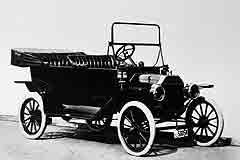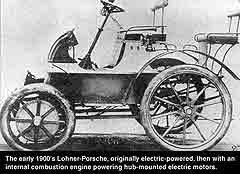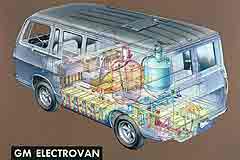With today's high gasoline prices, alternative fuels and hybrid electric vehicles are hot items. However, these alternative fuels like ethanol and biodiesel are as old as the automobile itself. Also the hybrid was 'invented' over a century ago.

Henry Ford advocated both recycling and renewable resources like agricultural products. The Model T was actually designed to run on ethyl alcohol, or ethanol, produced from corn. However, by the time the Model T appeared in 1905, gasoline was readily available, albeit from general stores, carriage shops, blacksmiths and liveries, which was not the case with ethanol. By 1920, the gasoline pumps were found throughout the country. There might be a lesson here for the hydrogen infrastructure. Automobiles and trucks were in widespread use long before the gasoline infrastructure was equally widespread.
From 1920 to 1924, the Standard Oil Company marketed a blend of 25-percent ethanol and 75-percent gasoline (it would be called E25 today) in the Baltimore area, but high corn prices combined with storage and transportation difficulties terminated the project. Henry Ford and several experts built a fermentation plant in Atchison, Kansas to produce ethanol fuel. During the 1930s, more than 2,000 service stations in the Midwest sold this ethanol made from corn, as gasohol. Gasohol could not compete with cheaper gasoline and the plant closed in the 1940s. Finally, many of us will remember another gasohol, a blend of 10-percent ethanol and 90-percent gasoline (E10) that appeared during the 1979 fuel crisis.
In the 1890s, Rudolf Diesel ran his first diesel engine on peanut oil that today would be called biodiesel. He believed diesel engines would operate on a variety of vegetable oils. But petroleum-based diesel fuel was cheap and readily available, so it quickly became the diesel fuel of choice.
By the late 1890s, electric vehicles (EV) were well developed in comparison to those powered by gasoline and steam. The years between 1898 and 1912 were the high point of electric vehicles in America. In 1905, 86-percent of the cars sold in the U.S. were powered by gasoline; electric and steam each captured about 7-percent of the market, the most in all EV history.
There are several reasons why gasoline won over electric and steam power. The simplistic answer often given is the invention of the electric starter by Charles "Boss" Kettering, which first appeared on the 1912 Cadillac. In reality, it was the cheap gasoline-powered car, most notably Henry Ford's Model T and the establishment of an infrastructure to keep them running down the road.
In the early 1900's electricity was still a novelty and usually only the wealthy could afford electricity in their homes. It was also expensive. Electric power plants were not standardized. Some generated DC power as favored by Edison, while others generated AC electricity as advocated by Tesla and Westinghouse. Furthermore, there was no standard DC voltage and yet no standard AC frequency. Also AC to DC rectifiers needed to charge batteries from AC power were still in their infancy and expensive. Much of rural America would not be electrified until the 1930s and even as late as 1945. Unlike gasoline cars that could travel virtually anywhere, electrics were pretty much confined to urban areas.

Further, limiting the electrics popularity was their high cost, range that did not improve to match that of the gasoline car, and relatively low top speed The range between recharges of only 30-50 miles, and in winter when batteries lost about 40 percent of their capacity. Also the poor roads of the day, frequently no more than cart paths shared with horse-drawn vehicles, turned to mud fields in bad weather. Electric cars, with their heavy batteries, were at a great disadvantage when they had to be pulled out of the mud. Another factor could have been the fact that because advertising for electric cars targeted women, men may have considered them a `woman's car.'" By the mid-1930, electric vehicle production essentially ceased.
One of Dr. Porsche's first designs, the 1900 Porsche-Lohner, was a 'hybrid' with electric drive motors built into the front wheel hubs with a gas engine driven generator supplying power. The Owen-Magnetic of the 1920s was a hybrid that it was an electric car with a gasoline engine driving a generator that supplied electricity to an 'electric' transmission.

Fuel cell-powered vehicles are much more recent. GM developed the first one, the Electrovan in 1966. This pioneering concept vehicle demonstrated the feasibility of a propulsion system using electrical power developed by cyrogenically stored hydrogen and oxygen combined with potassium hydroxide. There were no batteries to charge and no petroleum fuel.




